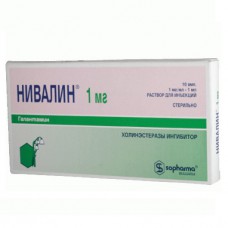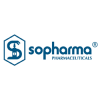Expiration date: 07/2026
The composition and form of issue:
Solution for injection. 1 ml contains galantamine hydrobromide 1, 2.5, 5 or 10 mg
excipients: sodium chloride water for injections
in glass ampoules of 1 ml in blistere 10 PCs., in box 1 or 10 blisters.
Description pharmaceutical form:
Transparent liquid from colorless to pale yellow.
Pharmacokinetics:
After subcutaneous injection of galantamine is rapidly absorbed. Therapeutic concentration in blood plasma is achieved within 30 min.
There was no statistically significant difference in the magnitude of area under the curve "concentration-time" (AUC) after a single application doses of 10 mg, introduced orally and parenterally.
Cmax in blood plasma after a single application doses of 10 mg, introduced orally and parenterally, equal to 1.2 mg/ml and is achieved within 2 h. during breeding, 5 HR.
Time poluraspredelenia galantamine — 10 min — longer compared to the time poluraspredelenia of neostigmine and pyridostigmine (5 and 6.6 min, respectively). T1/2 longer. Galantamine weakly associated with plasma proteins. It permeates through GEB and found in the tissues of the brain.
Metabolized by demethylation (5-6%). Metabolites of galantamine — epigalantamin and galantamine — detected in the plasma and urine.
Excreted mainly by glomerular filtration. A minor amount is excreted in the bile (0,2±0,1)%/24 h. Galantamine in unchanged form and its metabolites (galantamine, epigalantamin) 89% excreted in the urine after subcutaneous administration.
Found that the renal clearance of galantamine is about 100 ml/min In renal failure clearance is decreased.
Description pharmacological action:
Selective, competitive and reversible acetylcholinesterase inhibitor.
Means of reversible anticholinesterase action.
Facilitates the conduction of nerve impulses in the area of neuromuscular synapses strengthens the processes of excitation in the reflex zones of the spinal cord and brain, it permeates through the GEB.
Improves skin tone and stimulates contraction of smooth and skeletal muscles, the secretion of digestive and sweat glands, restores neuromuscular conductivity blockaded kurarepodobnymi drugs non-depolarizing type. Causes miosis, spasm of accommodation, lowers intraocular pressure in angle-closure glaucoma.
Indications:
- In neurology:
- traumatic injuries of the nervous system
- cerebral palsy
- diseases of the spinal cord (myelitis, polio, polio form of tick-borne encephalitis)
- manometric
- polyneuritis
- polyneuropathy
- polyradiculoneuritis
- the Guillain-Barre syndrome
- idiopathic facial nerve paresis
- myopathy
- bedwetting.
In anesthesiology and surgery:
as an antagonist of non-depolarizing muscle relaxants and for the treatment of postoperative intestinal atony and urinary bladder.
In physiotherapy:
in the form of iontophoresis in diseases of the peripheral nervous system.
In toxicology:
intoxication holinoblokirutmi drugs, morphine and its analogues.
In radiology:
to improve the quality of functional diagnostics of the digestive system including the gallbladder.
Contraindications:
- hypersensitivity to any component of the drug
- bronchial asthma
- bradycardia
- AV blockade
- angina
- severe heart failure
- epilepsy
- hyperkinesis
- severe renal/hepatic failure
- mechanical intestinal obstruction
- mechanical violations patency of the urinary tract
- pregnancy
- lactation
- children up to age 1 year.
With caution:
- renal failure
- violation of urination
- recent surgery on the prostate gland
- surgical intervention with the use of General anesthesia.
To improve the quality of radiographic the drug is not used in children.
Application of pregnancy and breast-feeding:
Contraindicated in pregnancy. At the time of treatment should stop breastfeeding.
Side effects:
Often — nausea, vomiting, diarrhea, abdominal pain, increased salivation, increased sweating, anorexia, fatigue, dizziness, headache, drowsiness and weight loss.
The following less frequent adverse reactions are: insomnia, rhinitis, bradycardia, blurred vision (accommodation spasm) and urinary tract infection, bronchospasm, intestinal and renal colic.
Drug interactions:
Is a weak antagonist of morphine and its structural analogs against oppressing action on the respiratory center.
Between galantamine and m-holinoblokatorov (atropine), a ganglionic (gexametoni benzolsulfonat, azametonia bromide, pahikarpin hydroiodide), a non-depolarizing muscle relaxants (tubocurarine et al), quinine and procainamide antagonism is manifested.
Aminoglycosides (gentamicin, amikacin) can reduce the therapeutic effect Nivalin.
Increases the effect of depolarizing muscle relaxants.
Cimetidine may increase the bioavailability of galantamine.
CYP2D6 and CYP3D4 are enzymes involved in the metabolism of galantamine. Quinidine, paroxetine, fluoxetine inhibit the enzyme CYP2D6, and drugs ketoconazole, zidovudine, erythromycin inhibit the CYP3D4 enzyme, so they can have an impact on the metabolism of galantamine, which can lead to the increase of its concentration in serum.
Method of application and dose:
P/to, in/m or/V.
The dose and course of treatment Nivalenol are determined depending on the severity of symptoms and individual response of the patient.
At the beginning of treatment prescribed is the minimum effective dose, gradually increasing it.
P/to the introduction
The highest single dose for adults — 10 mg, the highest daily dose of 20 mg.
Children: 1-2 years — 0,25–1,0 mg/day (0.1–0.2 ml of 0.25% solution) 3-5 years — 0,5–5,0 mg/day (0.2–0.4 ml of 0.25% solution) 6-8 years — 0,75–7,5 mg/day (0.3–0.4 ml of 0.25% solution) 9-11 years — 1,0–10,0 mg/day (0.5 ml of 0.25% or 0.6 ml of 0.5% solution) 12 to 15 years — 1,25–12,5 mg (0.7 ml 0.25% or 1 ml of 0.5% solution) 15-16 years — 12,5–20,0 mg (0.2 a-0.7 ml of 1% solution).
The duration of treatment depending on the characteristics and severity of the disease often 40-60 days. The treatment can be carried out 2-3 times with intermediate periods of 1-2 months. A big dose divided into 2 injections a day.
In/in the introduction
As an antagonist of non-depolarizing muscle relaxants administered to adults — 10-20 mg/day, children — 0.25–20 mg/day.
The/m introduction
When x-ray studies of Nivalin is used in adults at a dose of 1-5 mg.
In diseases of the peripheral nervous system and for treating bedwetting in children is applied in the form of iontophoresis at a dose of 1-2 ml 0.25% solution.
Overdose:
Symptoms: nausea, vomiting, colicky abdominal pain, diarrhea, decrease in blood pressure, bradycardia, bronchial spasm, and in more severe cases, convulsions and coma.
Treatment: symptomatic therapy, monitoring of respiratory function and cardiovascular system. As an antidote — I/atropine in a dose of 0.5–1 mg dose can be repeated depending on the clinical picture.
Special instructions:
During treatment should refrain from driving or operating complex machinery, as the drug can cause blurred vision, dizziness and drowsiness.




